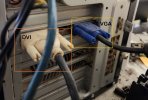britechguy
Well-Known Member
- Reaction score
- 4,852
- Location
- Staunton, VA
My latest client, the one who has the truly ancient custom build, does not wish to purchase new monitors (or at least not for the ones he has, a couple of new ones will be needed for additional computers), keyboards, etc.

[BTW: I know you all know the connector types, I annotated this photo of the owner's old tower connections for his education and still have the photo.]
I've used plenty of adapters of various types in the past, but never one for video. The replacement machines have only HDMI and DisplayPort outputs, and the two monitors I will be hooking up from the old box will be DVI and VGA respectively.
I'm thinking of going with 1080P HDMI Male to VGA Female adapters (as there are at least 3 VGA monitors across existing machines) and a USB 3.0 to DVI adapter for that monitor, which is the only one.
Have these been truly "plug n' play" for those who have used them in the past? If not, what are the likely tweaks that might need to be made?

[BTW: I know you all know the connector types, I annotated this photo of the owner's old tower connections for his education and still have the photo.]
I've used plenty of adapters of various types in the past, but never one for video. The replacement machines have only HDMI and DisplayPort outputs, and the two monitors I will be hooking up from the old box will be DVI and VGA respectively.
I'm thinking of going with 1080P HDMI Male to VGA Female adapters (as there are at least 3 VGA monitors across existing machines) and a USB 3.0 to DVI adapter for that monitor, which is the only one.
Have these been truly "plug n' play" for those who have used them in the past? If not, what are the likely tweaks that might need to be made?
